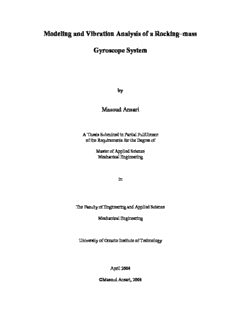Table Of ContentModeling and Vibration Analysis of a Rocking–mass
Gyroscope System
by
Masoud Ansari
A Thesis Submitted in Partial Fulfillment
of the Requirements for the Degree of
Master of Applied Science
Mechanical Engineering
in
The Faculty of Engineering and Applied Science
Mechanical Engineering
University of Ontario Institute of Technology
April 2008
©Masoud Ansari, 2008
ABSTRACT
Gyroscopes are one of the most widely used devices for measuring the
angle of rotation or the rate of change of angular rotation. In the last few
years, the advent of micromachining technology has made it possible to
fabricate high performance Micromachined Electro-Mechanical Systems
(MEMS) gyroscopes at a relatively low cost. Of the various types of MEMS
gyroscopes, vibrating beam type, are the most commonly used, but they have
a main drawback (cross-axis effect) which significantly affects their
measurement and results in much error. In view of this, the present work
focuses on a gyroscope, called rocking-mass gyroscope, which does not have
that drawback at all and can give a very precise measurement.
The rocking-mass gyroscope consists of an assembly of four cantilever
beams with a rigid mass attached to them in the middle subjected to base
rotations. Due to the gyroscopic effect, the beams undergo coupled flexural-
torsional vibrations. The main goal of the research is to develop an accurate
model of such a system and along this line a detailed mathematical modeling
of the gyroscope is developed for a macro-scaled system. The equations of
motion clearly show the presence of the gyroscopic couplings in all cantilever
beams. In order to analyze the effectiveness of this type of gyroscope a
computer simulation model in its most general form has been developed.
iii
Before deriving the governing equations of motion for a rocking-mass
gyroscope, a detailed mathematical model of a single beam gyroscope was
considered to investigate the cross-axis effect in this type of gyroscopes.
The characteristic equation of a rocking-mass gyroscope, using an
exact method, is derived, and the fundamental frequency of the vibration and
the corresponding mode shape are obtained. Finally, the time history diagram
of this system is presented to illustrate the dynamic response of the system.
Simulation results show that the bending vibrations induced in the second and
the forth beams are directly proportional to the magnitude of the base rotation.
Therefore, the gyroscope can be widely used as a device for measuring the
base rotation velocity.
Keywords
Rocking-mass gyroscope; Vibrating beam gyroscope; Extended
Hamilton’s principle; Frequency analysis; Mathematical modeling.
iv
Dedication
To my father Jamshid and my mother Shahnaz who influenced my life
the most.
v
Acknowledgments
I would like to sincerely and wholeheartedly thank Prof. E. Esmailzadeh for
his guidance and kindness throughout this work. His patience as an advisor,
boundless energy while teaching, promptness while reviewing all my writing,
and passion for doing research are to be commended and worth emulating.
This thesis would not have been possible without his support.
I would also like to thank my advisory committee members Dr. Dan Zhang
and Dr. Greg Lewis for giving their valuable time and for serving on my
thesis committee.
I am grateful to Dr. Nader Jalili of Clemson University for his constant
guidance and motivation during this research work.
A special thanks to Ms. Jane Dubis and Ms. Kathryn Hanson in the university
library for all their cooperation and help during my course of study at UOIT.
Most importantly, I would like to thank my parents, Jamshid and Shahnaz,
and my sisters Maryam and Marzieh, for their unconditional support, love and
affection. Their encouragement and never-ending kindness made everything
easier to achieve.
vi
Table of Contents
Title Page……………………………………………………………...……….i
Abstract………………………………………………….…………………...iii
Dedication………………………………………………..……………….…...v
Acknowledgements……………………………………..……………….…...vi
Table of Contents……………….…………………………………….……..vii
List of Tables……………………………………………………...………….xi
List of Figures……………………………………………………..………...xii
List of Appendices…………………………………………….….......…….xiii
CHAPTERS
1. INTRODUCTION……………………………………………………….....1
Research Background….………………………………………………1
Thesis Contributions…….……………………………………………..4
Thesis Outline………….………………………………………………5
2. OVERVIEW OF GYROSCOPE TECHNOLOGY………………...………7
Introduction……………………………………………………………7
vii
Micromachined Vibratory Rate Gyroscopes and Their Operational
Principles……………………………………………………………..11
Specifications of MEMS Gyroscopes ……………………..…………13
Applications of MEMS Gyroscopes……………….…………………14
Different Types of MEMS Vibratory Gyroscopes …..………………16
Control Strategies of MEMS Gyroscopes ……..….…………………23
Summary………………………………………………………...……26
3. OVERVIEW OF SINGLE BEAM GYROSCOPE…………………….…27
Introduction……………………………………………..……………27
Governing Equations of Motion…………...…………………………31
Beam Kinematics……………………………………………………..32
Translational Motion……………………………………………..…..33
Rotational Motion……………………………………………….……37
Piezoelectric Modeling……………………………………………….40
Constitutive Equations...…………………………………………...…41
Piezoelectric Patch Actuator....………………...………………….….42
Effects of Piezoelectric Actuator………………………...…………...43
Equations of Motion…………………..……………………………...45
viii
Time Response………………...………………..……………………48
Cross-axis Effects..…………………………………………………...52
Summary………………………………………………………...……54
4. MODELING OF THE ROCKING-MASS GYROSCOPE……………….55
Introduction………………………………………………………..…55
Principle of Operation...…………………………………………….. 56
Governing Equations of Motion...……………………………………59
Translational Motion….……………………………………………...60
Rotational Motion………………………………………………….…61
Equations of motion………...………………………………………...63
Summary………………….…………………………………………..70
5. ROCKING-MASS GYROSCOPE ANALYSIS AND NUMERICAL
SIMULATIONS……………………………………………………………..71
Development of the Frequency Equation…….………………………72
Validation of the Utilized Method for Solving EVP………..………..83
Frequency Analysis of a Timoshenko Beam…………………………83
Time Response of the System………………..………………………89
Summary………………………………………..….…………………93
ix
6. CONCLUSIONS AND FUTURE WORK………..………………………94
Recommendations for Future Work………………………………….95
APPENDICES………………………………………….…………………………96
A: Detailed Derivation of Equations of Motion for a Single Beam
Gyroscope…………...………………………………………………..97
B: Frequency Equation…….……………………………………..…101
C: Maple Code to Develop the Frequency Equation………………..104
REFERENCES.………………………………………………….…………110
x
Description:Modeling and Vibration Analysis of a Rocking–mass. Gyroscope System by. Masoud Ansari. A Thesis Submitted in Partial Fulfillment of the Requirements for the Degree of. Master of Applied Science. Mechanical Engineering in. The Faculty of Engineering and Applied Science. Mechanical Engineering.

